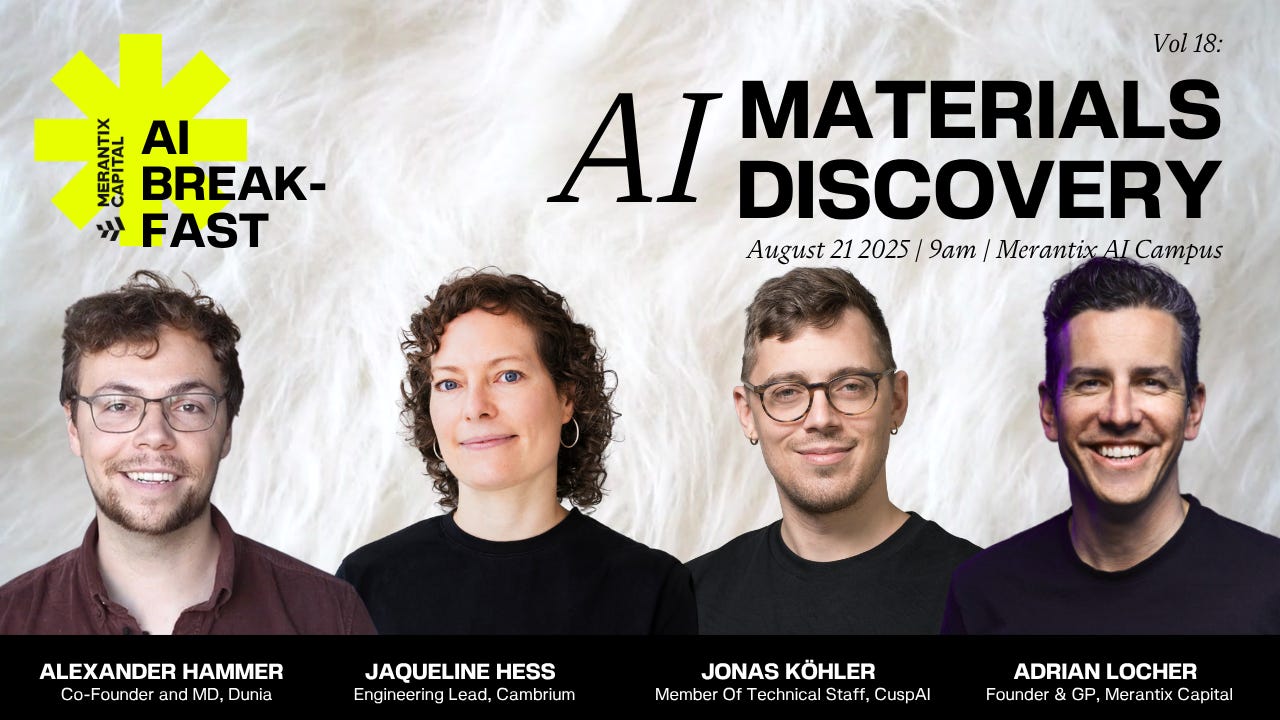Why we invest in AI for materials discovery
We’re used to thinking of AI in the digital realm. But its biggest impact could come through the design of physical matter itself.
The earliest applications of AI have made us used to thinking of it in the context of software: intangible, abstract, algorithmic. Or how I just asked ChatGPT to make the picture above for this article.
But AI’s most transformative applications will most likely emerge in the physical world, where it can reshape how we design and scale new materials.
That’s why materials discovery is one of our biggest areas of interest at Merantix Capital. Our portfolio already includes Cambrium, a company born out of our venture studio that designs novel proteins.
If you are in Berlin, we are hosting an AI Breakfast on Thursday 21st August at the Merantix AI Campus to explore these ideas in more depth, with speakers from Cambrium, CuspAI, Dunia, and our own GP Adrian Locher.
If you’re already building in this space (or are keen to), we’d love to see you there!
Why we like the space
Materials have long been the hidden foundation of progress, underpinning advances in semiconductors, solar cells, batteries, and carbon capture. Now, AI is accelerating every stage of their development. It proposes novel compounds, predicts their properties, and links design directly to manufacturing constraints. This convergence opens the possibility of building entirely new materials platforms that are faster, more cost-effective, and more adaptable than ever before.
The next generation of materials giants will fuse deep technology with industrial relevance and, most importantly, help address some of the most urgent challenges of our time, like clean energy and sustainable production.
For years, computational chemistry served as a tool to simulate a few candidate molecules before testing them in the lab. The process still relied on human intuition to select what to simulate but, today, large-scale AI models don’t just evaluate known materials. They propose novel ones at unprecedented scale.
DeepMind’s GNoME project, for instance, trained a graph neural network to predict the stability of inorganic crystal structures. Researchers at Berkeley Lab for their part built A-Lab, an autonomous discovery platform combining machine learning, robotic synthesis, and automated measurement. In a 17-day trial, it completed 355 experiments and discovered 41 new inorganic compounds, all guided by active learning algorithms that improved in real time.
Designing for Scale
Big as these developments in R&D, they’re only going to help drive forward science if they can be applied at scale. That’s why a new cohort of startups are building their discovery platforms with production in mind from the beginning.
Cambrium is taking this scale-oriented approach into the world of protein materials. The company uses AI to design novel proteins that do not exist in nature and produces them through microbial fermentation, allowing for a more flexible and sustainable production process. From the start, its design process has been built around manufacturability, with a focus on properties like thermal stability, fermentation yield, and compatibility with existing bioproduction infrastructure.
This approach led to a fivefold increase in development speed and a twentyfold reduction in cost compared to traditional protein engineering workflows. One of Cambrium’s first products, NovaColl, is a sustainable collagen alternative that achieves a 95 percent lower carbon footprint and was developed in under two years.
In climate-focused materials, CuspAI is using generative AI to design bespoke porous compounds for applications like carbon capture and gas separation. The platform functions like a “search engine” for materials, generating and evaluating candidates that match specific performance criteria, including CO₂ selectivity and release dynamics. This approach has significantly shortened development timelines, reducing discovery cycles from years to months and achieving success rates of around 90 percent in generating viable materials. While still early, CuspAI is prioritising industrial deployment by designing materials that not only perform well in theory but also meet practical requirements such as regeneration efficiency and compatibility with existing capture systems.
Materials Nexus is another example addressing the supply chain risks associated with rare-earth elements by using AI to design alternative permanent magnets. In collaboration with the University of Sheffield and the Henry Royce Institute, the company screened more than 100 million candidate materials to develop MagNex, a rare-earth-free magnet suitable for use in electric vehicles and wind turbines. The material was taken from concept to synthesis in just three months and can be manufactured at around 20 percent of the cost of typical rare-earth magnets, with a 70 percent reduction in carbon emissions per kilogram produced.
XtalPi may have started in pharmaceutical discovery, but its AI-powered R&D platform is now proving adaptable to materials science, including solid-state research. The company offers tools tailored to structure prediction, experimental solid-state chemistry, and automated crystallography, collectively marketed under the “XtalGazer” and digital chemistry suite. Since 2024, XtalPi’s public filings confirm that its platform is being deployed for electrochemical and new energy material development, such as battery electrolytes and advanced ceramics, often in collaboration with partners like GCL Group and Fangda Carbon. These developments demonstrate how an AI-native discovery stack, once proven in one sector, can be repurposed to serve adjacent industries with minimal changes.
Together, these companies illustrate a broader shift: materials discovery is no longer just about predicting what might work in a lab. It’s about building entire pipelines that move from concept to manufacturable product with speed, precision, and commercial focus. By starting with real-world constraints such as cost, scale, and performance, this new wave of ventures is showing that AI-native materials platforms can make a meaningful impact far beyond the simulation stage. The next question is where new founders can still add value.
Where Founders can build
Founders entering the materials space face distinct challenges and opportunities. Initial traction tends to emerge in industries where performance matters more than cost. Markets such as cosmetics, fashion, and specialty coatings offer fast sales cycles and customers willing to pay for novelty, differentiation, or sustainability. These sectors provide early revenue, which can fund further technical development and create defensible IP.
Over time, the opportunity expands into heavier industries. Sectors like construction, packaging, agriculture and energy require greater investment in scale and compliance but offer outsized long-term value. In these markets, success depends not just on novel discovery but on the ability to integrate with supply chains and meet regulatory standards.
Strategically, founders can choose different entry points across the stack:
Some will focus on software platforms, offering prediction tools to chemical companies or research institutions.
Others will partner with OEMs, co-developing materials while relying on partners for scale-up.
A third category will go full stack, owning discovery, validation, and production in-house.
Each approach carries trade-offs in capital requirements and speed, but all benefit from tighter control over learning cycles.
What is still missing in the ecosystem presents new possibilities. Lab automation remains capital-intensive and geographically limited. There is a shortage of multimodal models capable of integrating structural, textual, and experimental data. And very few infrastructure tools exist to bridge gram-scale discovery with ton-scale manufacturing.
In this landscape, speed of iteration becomes the key source of defensibility. Teams that can cycle faster, learn from data, and apply those insights across markets will build the next category-defining materials companies.
I’m always looking to hear from founders in materials discovery — if this article speaks to you or you have an idea you want to develop, get in touch or come along to our AI Breakfast this Thursday in Berlin.



